Strategic Management & Change: CMA CGM's Path to Sustainability
VerifiedAdded on 2023/04/22
|28
|5629
|152
Report
AI Summary
This report critically reviews the strategic plans of CMA CGM, a leading global shipping company, in the context of a changing business environment. It analyzes the drivers and resistors of change, focusing on technological advancements aimed at reducing fuel expenditure and environmental pollution. The report includes a force field analysis, examining internal developments like shipbuilding and smart ships, as well as external developments such as advanced materials and big data analytics. It identifies financial challenges and cyber threats as key resistors to change. Furthermore, the report proposes a suitable structure for implementing strategic plans, creates a resource implementation plan, identifies key success indicators, and addresses potential risks during implementation. This analysis provides a comprehensive overview of CMA CGM's strategic management and change initiatives, highlighting the complexities and opportunities in the global marine logistics industry. Desklib offers similar solved assignments and past papers for students.
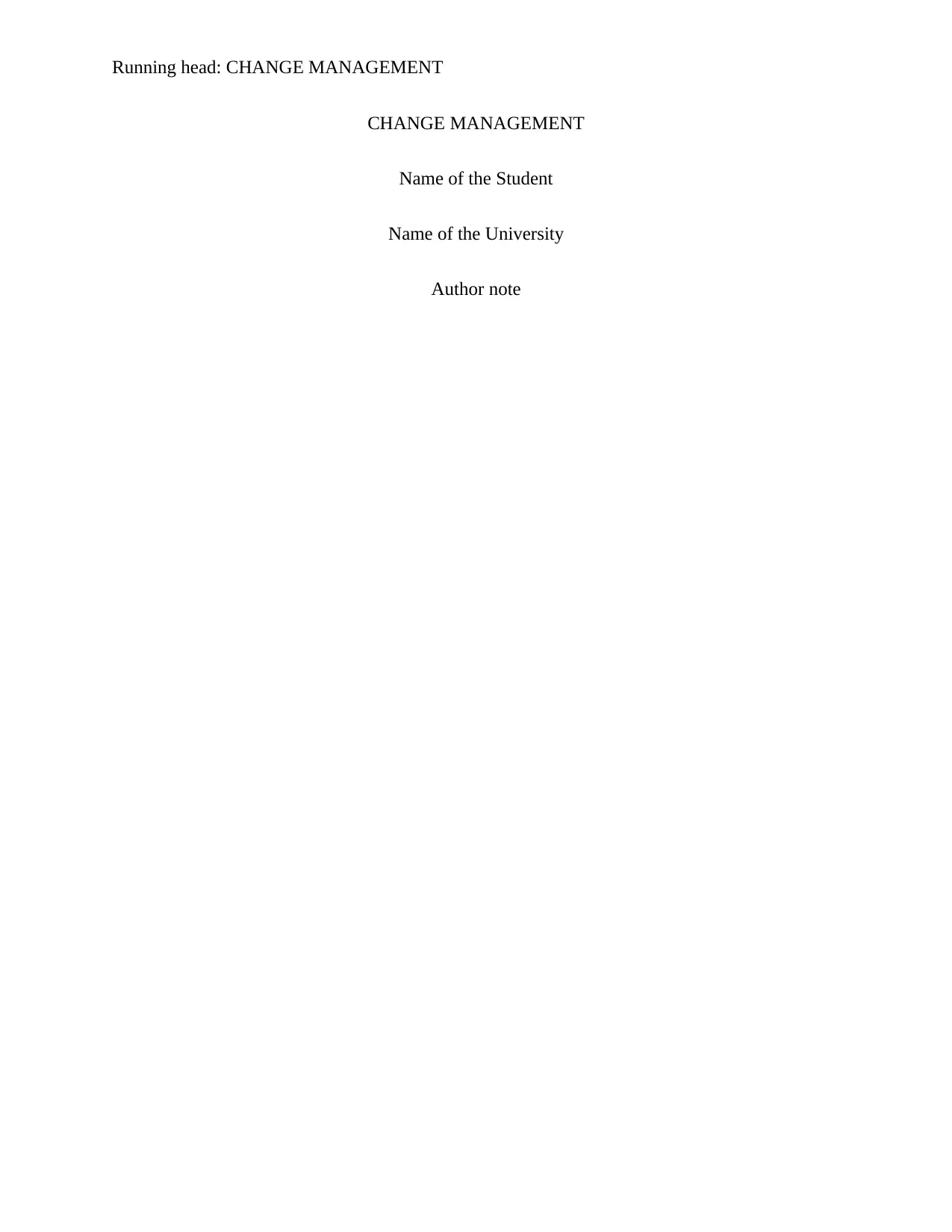
Running head: CHANGE MANAGEMENT
CHANGE MANAGEMENT
Name of the Student
Name of the University
Author note
CHANGE MANAGEMENT
Name of the Student
Name of the University
Author note
Paraphrase This Document
Need a fresh take? Get an instant paraphrase of this document with our AI Paraphraser
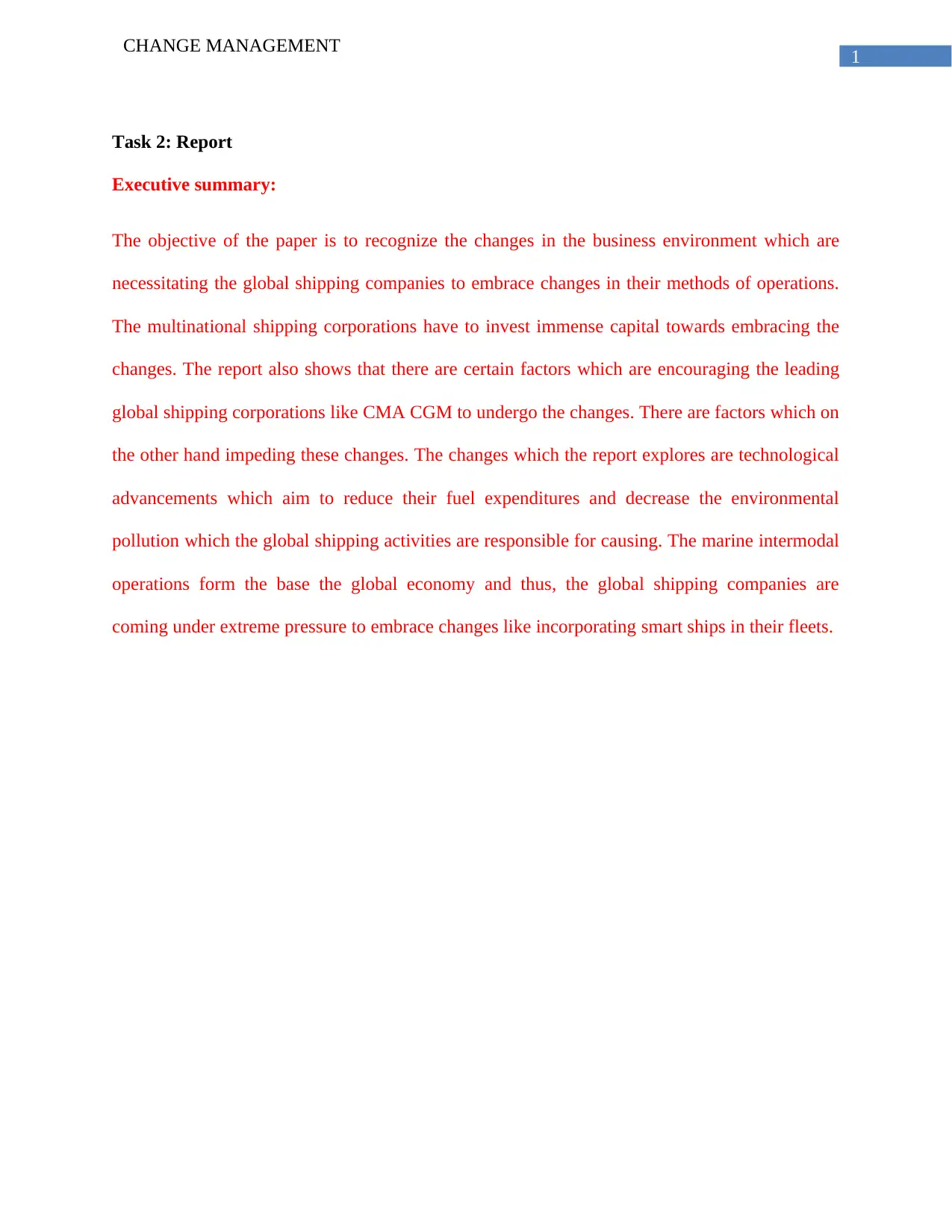
1
CHANGE MANAGEMENT
Task 2: Report
Executive summary:
The objective of the paper is to recognize the changes in the business environment which are
necessitating the global shipping companies to embrace changes in their methods of operations.
The multinational shipping corporations have to invest immense capital towards embracing the
changes. The report also shows that there are certain factors which are encouraging the leading
global shipping corporations like CMA CGM to undergo the changes. There are factors which on
the other hand impeding these changes. The changes which the report explores are technological
advancements which aim to reduce their fuel expenditures and decrease the environmental
pollution which the global shipping activities are responsible for causing. The marine intermodal
operations form the base the global economy and thus, the global shipping companies are
coming under extreme pressure to embrace changes like incorporating smart ships in their fleets.
CHANGE MANAGEMENT
Task 2: Report
Executive summary:
The objective of the paper is to recognize the changes in the business environment which are
necessitating the global shipping companies to embrace changes in their methods of operations.
The multinational shipping corporations have to invest immense capital towards embracing the
changes. The report also shows that there are certain factors which are encouraging the leading
global shipping corporations like CMA CGM to undergo the changes. There are factors which on
the other hand impeding these changes. The changes which the report explores are technological
advancements which aim to reduce their fuel expenditures and decrease the environmental
pollution which the global shipping activities are responsible for causing. The marine intermodal
operations form the base the global economy and thus, the global shipping companies are
coming under extreme pressure to embrace changes like incorporating smart ships in their fleets.
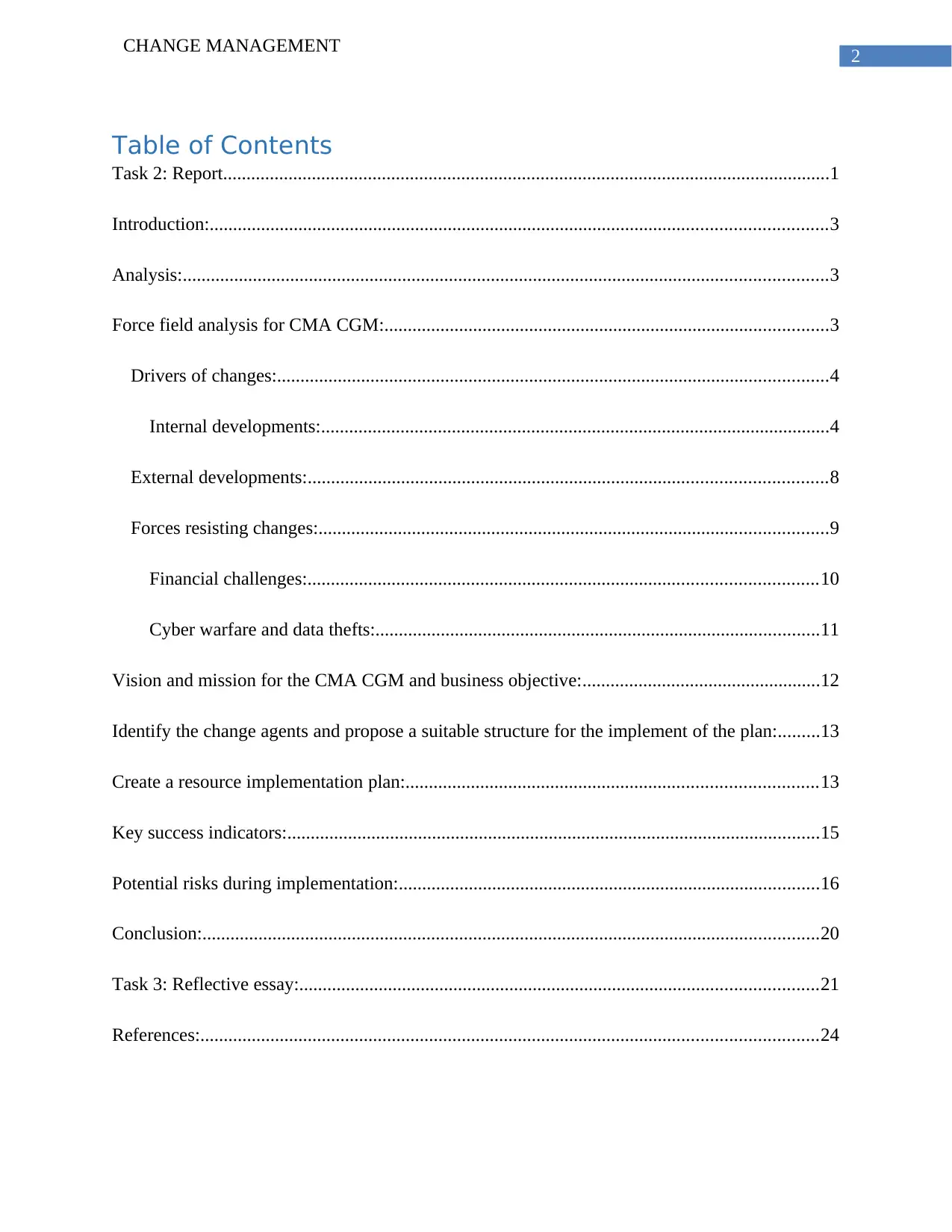
2
CHANGE MANAGEMENT
Table of Contents
Task 2: Report..................................................................................................................................1
Introduction:....................................................................................................................................3
Analysis:..........................................................................................................................................3
Force field analysis for CMA CGM:...............................................................................................3
Drivers of changes:......................................................................................................................4
Internal developments:.............................................................................................................4
External developments:...............................................................................................................8
Forces resisting changes:.............................................................................................................9
Financial challenges:.............................................................................................................10
Cyber warfare and data thefts:...............................................................................................11
Vision and mission for the CMA CGM and business objective:...................................................12
Identify the change agents and propose a suitable structure for the implement of the plan:.........13
Create a resource implementation plan:........................................................................................13
Key success indicators:..................................................................................................................15
Potential risks during implementation:..........................................................................................16
Conclusion:....................................................................................................................................20
Task 3: Reflective essay:...............................................................................................................21
References:....................................................................................................................................24
CHANGE MANAGEMENT
Table of Contents
Task 2: Report..................................................................................................................................1
Introduction:....................................................................................................................................3
Analysis:..........................................................................................................................................3
Force field analysis for CMA CGM:...............................................................................................3
Drivers of changes:......................................................................................................................4
Internal developments:.............................................................................................................4
External developments:...............................................................................................................8
Forces resisting changes:.............................................................................................................9
Financial challenges:.............................................................................................................10
Cyber warfare and data thefts:...............................................................................................11
Vision and mission for the CMA CGM and business objective:...................................................12
Identify the change agents and propose a suitable structure for the implement of the plan:.........13
Create a resource implementation plan:........................................................................................13
Key success indicators:..................................................................................................................15
Potential risks during implementation:..........................................................................................16
Conclusion:....................................................................................................................................20
Task 3: Reflective essay:...............................................................................................................21
References:....................................................................................................................................24
⊘ This is a preview!⊘
Do you want full access?
Subscribe today to unlock all pages.

Trusted by 1+ million students worldwide
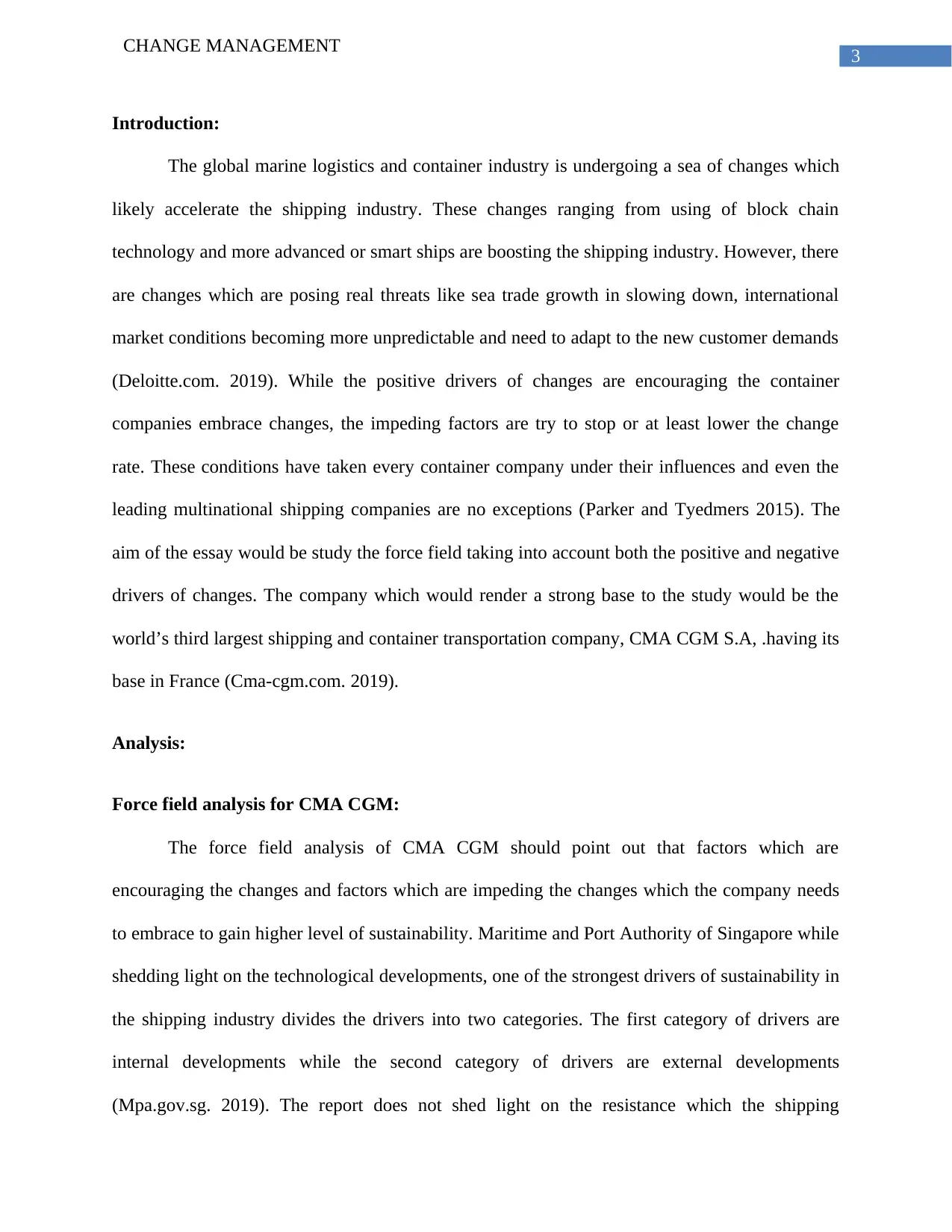
3
CHANGE MANAGEMENT
Introduction:
The global marine logistics and container industry is undergoing a sea of changes which
likely accelerate the shipping industry. These changes ranging from using of block chain
technology and more advanced or smart ships are boosting the shipping industry. However, there
are changes which are posing real threats like sea trade growth in slowing down, international
market conditions becoming more unpredictable and need to adapt to the new customer demands
(Deloitte.com. 2019). While the positive drivers of changes are encouraging the container
companies embrace changes, the impeding factors are try to stop or at least lower the change
rate. These conditions have taken every container company under their influences and even the
leading multinational shipping companies are no exceptions (Parker and Tyedmers 2015). The
aim of the essay would be study the force field taking into account both the positive and negative
drivers of changes. The company which would render a strong base to the study would be the
world’s third largest shipping and container transportation company, CMA CGM S.A, .having its
base in France (Cma-cgm.com. 2019).
Analysis:
Force field analysis for CMA CGM:
The force field analysis of CMA CGM should point out that factors which are
encouraging the changes and factors which are impeding the changes which the company needs
to embrace to gain higher level of sustainability. Maritime and Port Authority of Singapore while
shedding light on the technological developments, one of the strongest drivers of sustainability in
the shipping industry divides the drivers into two categories. The first category of drivers are
internal developments while the second category of drivers are external developments
(Mpa.gov.sg. 2019). The report does not shed light on the resistance which the shipping
CHANGE MANAGEMENT
Introduction:
The global marine logistics and container industry is undergoing a sea of changes which
likely accelerate the shipping industry. These changes ranging from using of block chain
technology and more advanced or smart ships are boosting the shipping industry. However, there
are changes which are posing real threats like sea trade growth in slowing down, international
market conditions becoming more unpredictable and need to adapt to the new customer demands
(Deloitte.com. 2019). While the positive drivers of changes are encouraging the container
companies embrace changes, the impeding factors are try to stop or at least lower the change
rate. These conditions have taken every container company under their influences and even the
leading multinational shipping companies are no exceptions (Parker and Tyedmers 2015). The
aim of the essay would be study the force field taking into account both the positive and negative
drivers of changes. The company which would render a strong base to the study would be the
world’s third largest shipping and container transportation company, CMA CGM S.A, .having its
base in France (Cma-cgm.com. 2019).
Analysis:
Force field analysis for CMA CGM:
The force field analysis of CMA CGM should point out that factors which are
encouraging the changes and factors which are impeding the changes which the company needs
to embrace to gain higher level of sustainability. Maritime and Port Authority of Singapore while
shedding light on the technological developments, one of the strongest drivers of sustainability in
the shipping industry divides the drivers into two categories. The first category of drivers are
internal developments while the second category of drivers are external developments
(Mpa.gov.sg. 2019). The report does not shed light on the resistance which the shipping
Paraphrase This Document
Need a fresh take? Get an instant paraphrase of this document with our AI Paraphraser
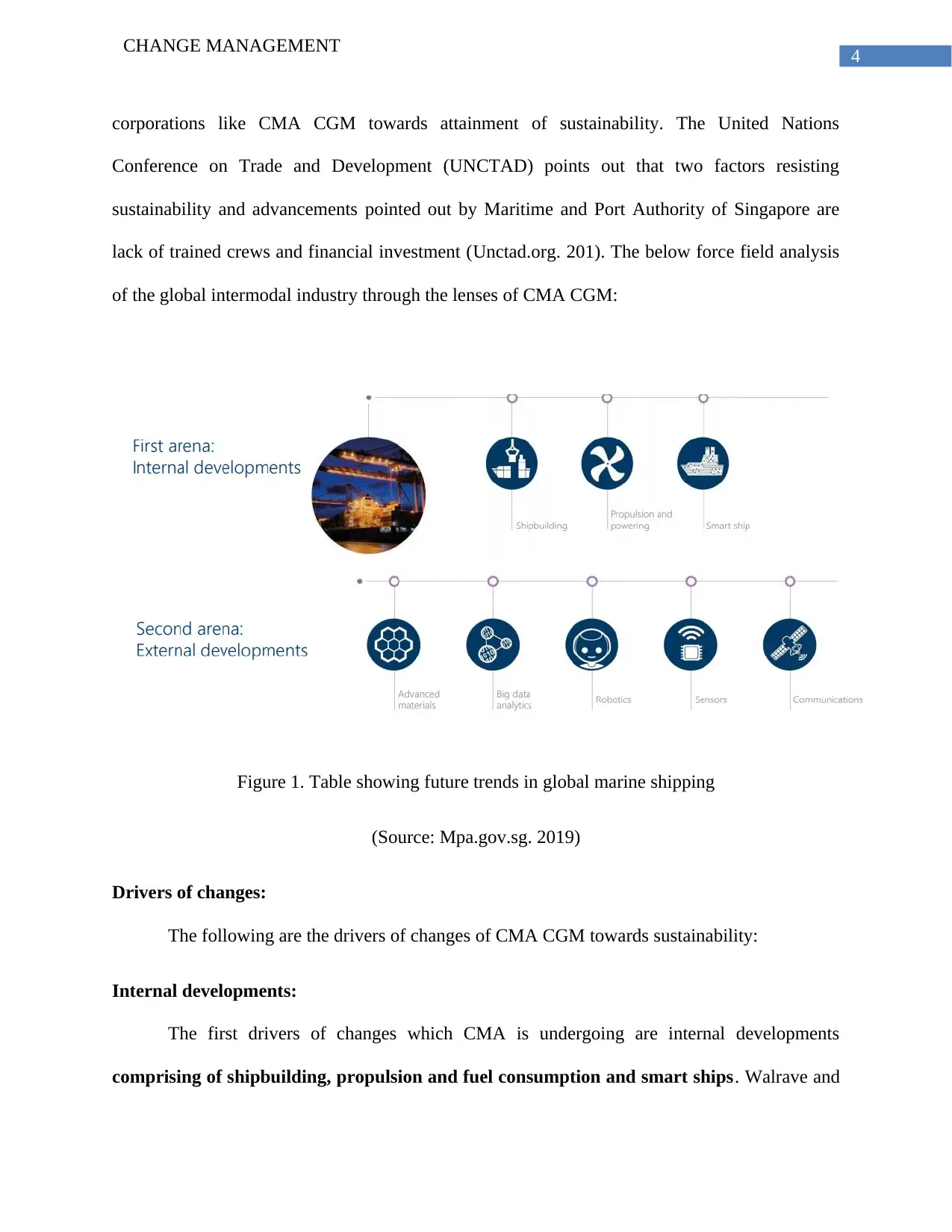
4
CHANGE MANAGEMENT
corporations like CMA CGM towards attainment of sustainability. The United Nations
Conference on Trade and Development (UNCTAD) points out that two factors resisting
sustainability and advancements pointed out by Maritime and Port Authority of Singapore are
lack of trained crews and financial investment (Unctad.org. 201). The below force field analysis
of the global intermodal industry through the lenses of CMA CGM:
Figure 1. Table showing future trends in global marine shipping
(Source: Mpa.gov.sg. 2019)
Drivers of changes:
The following are the drivers of changes of CMA CGM towards sustainability:
Internal developments:
The first drivers of changes which CMA is undergoing are internal developments
comprising of shipbuilding, propulsion and fuel consumption and smart ships. Walrave and
CHANGE MANAGEMENT
corporations like CMA CGM towards attainment of sustainability. The United Nations
Conference on Trade and Development (UNCTAD) points out that two factors resisting
sustainability and advancements pointed out by Maritime and Port Authority of Singapore are
lack of trained crews and financial investment (Unctad.org. 201). The below force field analysis
of the global intermodal industry through the lenses of CMA CGM:
Figure 1. Table showing future trends in global marine shipping
(Source: Mpa.gov.sg. 2019)
Drivers of changes:
The following are the drivers of changes of CMA CGM towards sustainability:
Internal developments:
The first drivers of changes which CMA is undergoing are internal developments
comprising of shipbuilding, propulsion and fuel consumption and smart ships. Walrave and
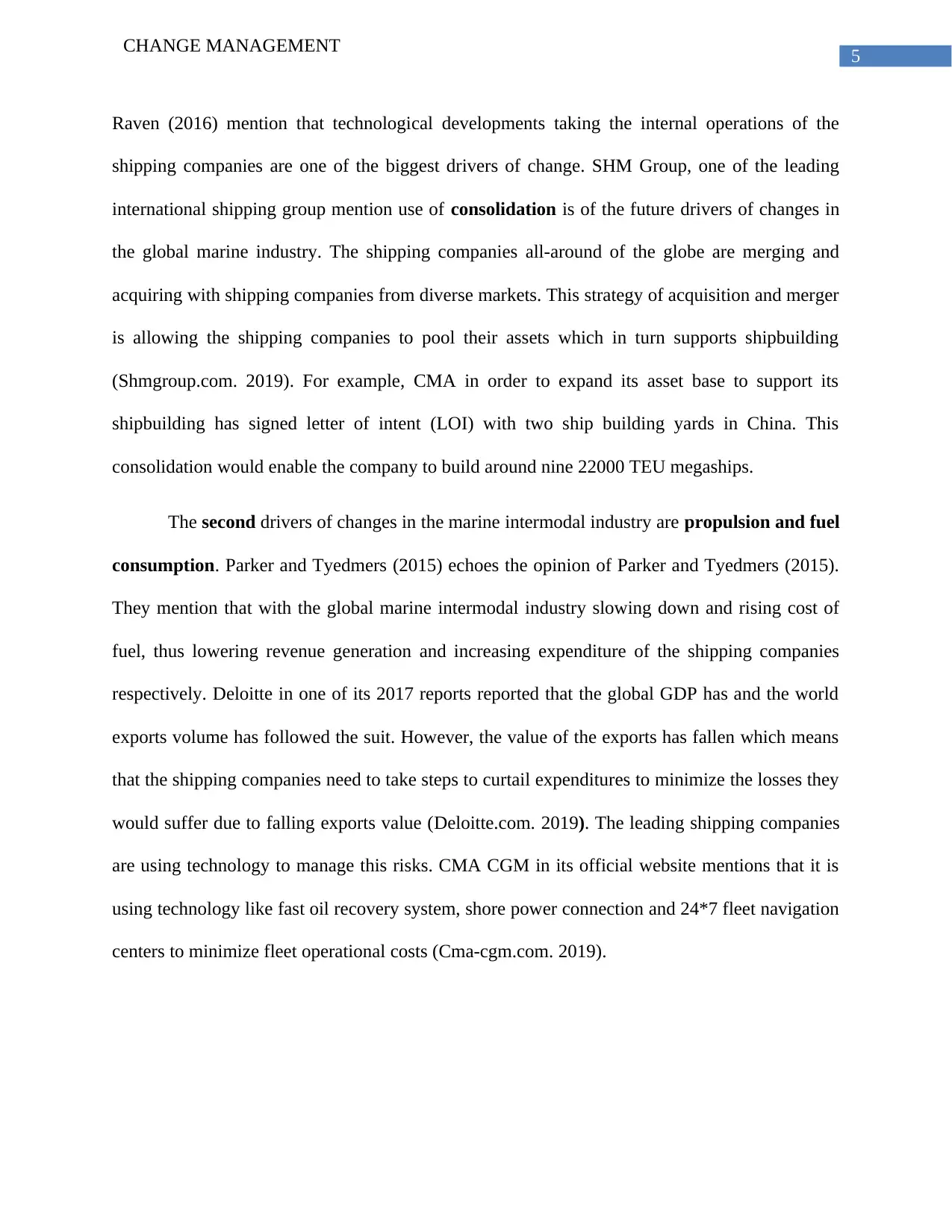
5
CHANGE MANAGEMENT
Raven (2016) mention that technological developments taking the internal operations of the
shipping companies are one of the biggest drivers of change. SHM Group, one of the leading
international shipping group mention use of consolidation is of the future drivers of changes in
the global marine industry. The shipping companies all-around of the globe are merging and
acquiring with shipping companies from diverse markets. This strategy of acquisition and merger
is allowing the shipping companies to pool their assets which in turn supports shipbuilding
(Shmgroup.com. 2019). For example, CMA in order to expand its asset base to support its
shipbuilding has signed letter of intent (LOI) with two ship building yards in China. This
consolidation would enable the company to build around nine 22000 TEU megaships.
The second drivers of changes in the marine intermodal industry are propulsion and fuel
consumption. Parker and Tyedmers (2015) echoes the opinion of Parker and Tyedmers (2015).
They mention that with the global marine intermodal industry slowing down and rising cost of
fuel, thus lowering revenue generation and increasing expenditure of the shipping companies
respectively. Deloitte in one of its 2017 reports reported that the global GDP has and the world
exports volume has followed the suit. However, the value of the exports has fallen which means
that the shipping companies need to take steps to curtail expenditures to minimize the losses they
would suffer due to falling exports value (Deloitte.com. 2019). The leading shipping companies
are using technology to manage this risks. CMA CGM in its official website mentions that it is
using technology like fast oil recovery system, shore power connection and 24*7 fleet navigation
centers to minimize fleet operational costs (Cma-cgm.com. 2019).
CHANGE MANAGEMENT
Raven (2016) mention that technological developments taking the internal operations of the
shipping companies are one of the biggest drivers of change. SHM Group, one of the leading
international shipping group mention use of consolidation is of the future drivers of changes in
the global marine industry. The shipping companies all-around of the globe are merging and
acquiring with shipping companies from diverse markets. This strategy of acquisition and merger
is allowing the shipping companies to pool their assets which in turn supports shipbuilding
(Shmgroup.com. 2019). For example, CMA in order to expand its asset base to support its
shipbuilding has signed letter of intent (LOI) with two ship building yards in China. This
consolidation would enable the company to build around nine 22000 TEU megaships.
The second drivers of changes in the marine intermodal industry are propulsion and fuel
consumption. Parker and Tyedmers (2015) echoes the opinion of Parker and Tyedmers (2015).
They mention that with the global marine intermodal industry slowing down and rising cost of
fuel, thus lowering revenue generation and increasing expenditure of the shipping companies
respectively. Deloitte in one of its 2017 reports reported that the global GDP has and the world
exports volume has followed the suit. However, the value of the exports has fallen which means
that the shipping companies need to take steps to curtail expenditures to minimize the losses they
would suffer due to falling exports value (Deloitte.com. 2019). The leading shipping companies
are using technology to manage this risks. CMA CGM in its official website mentions that it is
using technology like fast oil recovery system, shore power connection and 24*7 fleet navigation
centers to minimize fleet operational costs (Cma-cgm.com. 2019).
⊘ This is a preview!⊘
Do you want full access?
Subscribe today to unlock all pages.

Trusted by 1+ million students worldwide
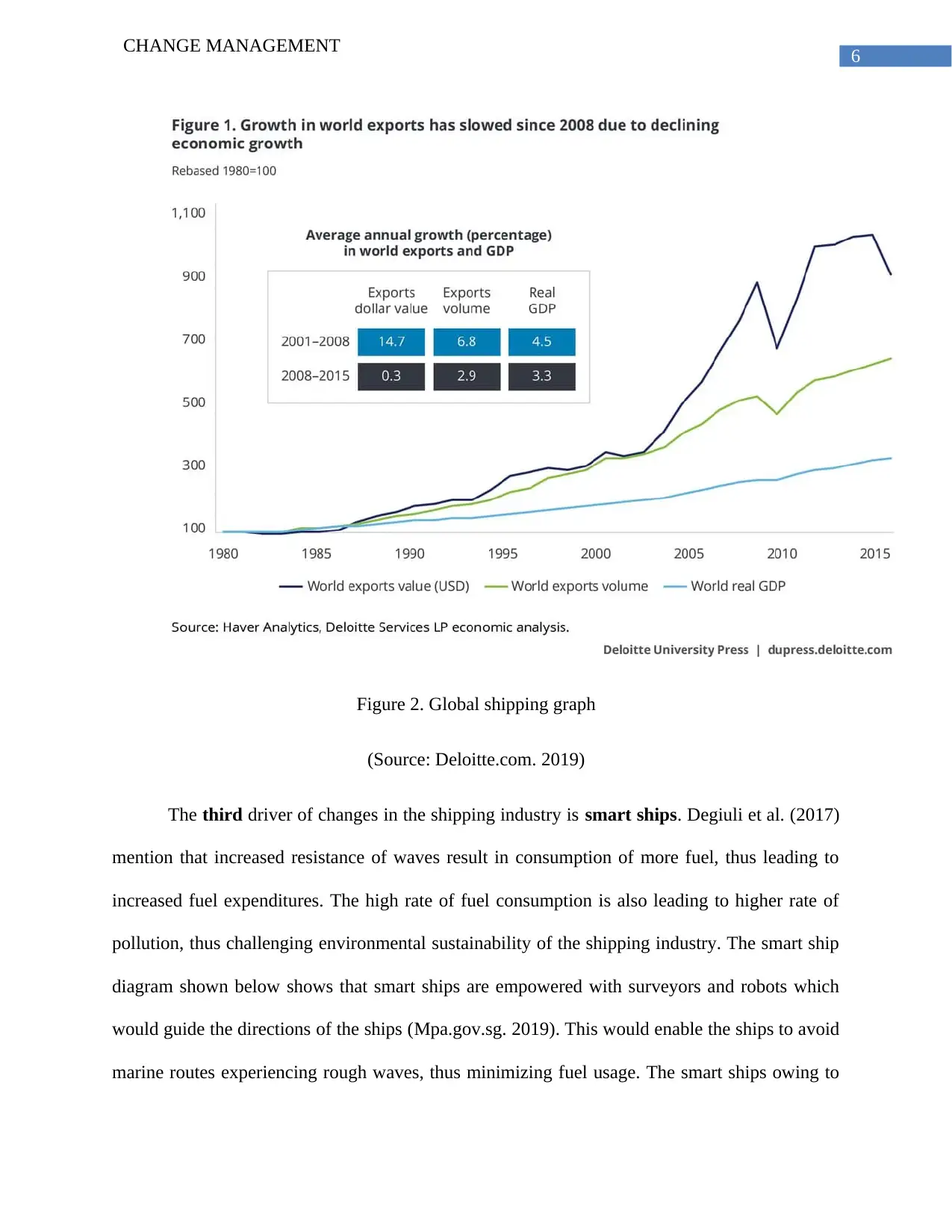
6
CHANGE MANAGEMENT
Figure 2. Global shipping graph
(Source: Deloitte.com. 2019)
The third driver of changes in the shipping industry is smart ships. Degiuli et al. (2017)
mention that increased resistance of waves result in consumption of more fuel, thus leading to
increased fuel expenditures. The high rate of fuel consumption is also leading to higher rate of
pollution, thus challenging environmental sustainability of the shipping industry. The smart ship
diagram shown below shows that smart ships are empowered with surveyors and robots which
would guide the directions of the ships (Mpa.gov.sg. 2019). This would enable the ships to avoid
marine routes experiencing rough waves, thus minimizing fuel usage. The smart ships owing to
CHANGE MANAGEMENT
Figure 2. Global shipping graph
(Source: Deloitte.com. 2019)
The third driver of changes in the shipping industry is smart ships. Degiuli et al. (2017)
mention that increased resistance of waves result in consumption of more fuel, thus leading to
increased fuel expenditures. The high rate of fuel consumption is also leading to higher rate of
pollution, thus challenging environmental sustainability of the shipping industry. The smart ship
diagram shown below shows that smart ships are empowered with surveyors and robots which
would guide the directions of the ships (Mpa.gov.sg. 2019). This would enable the ships to avoid
marine routes experiencing rough waves, thus minimizing fuel usage. The smart ships owing to
Paraphrase This Document
Need a fresh take? Get an instant paraphrase of this document with our AI Paraphraser
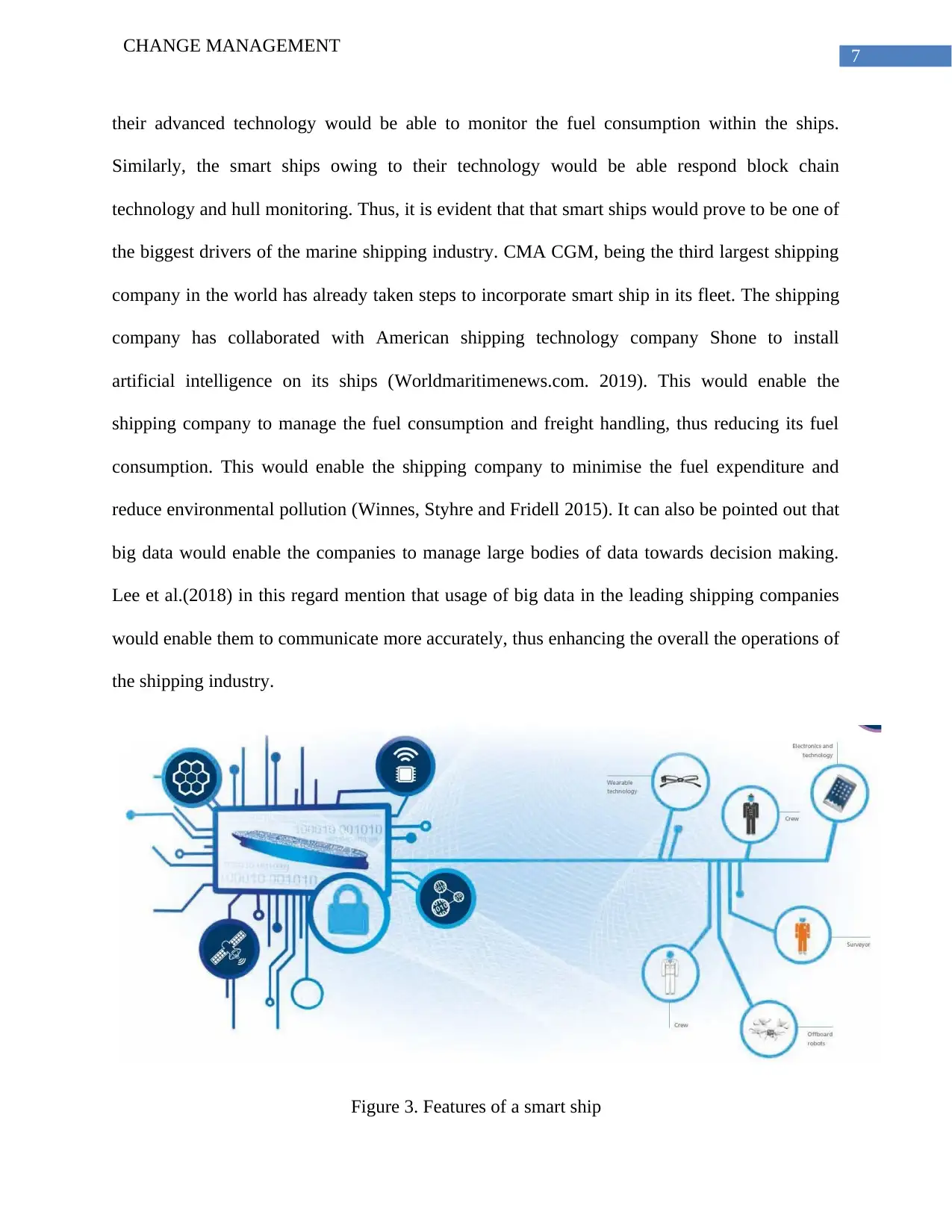
7
CHANGE MANAGEMENT
their advanced technology would be able to monitor the fuel consumption within the ships.
Similarly, the smart ships owing to their technology would be able respond block chain
technology and hull monitoring. Thus, it is evident that that smart ships would prove to be one of
the biggest drivers of the marine shipping industry. CMA CGM, being the third largest shipping
company in the world has already taken steps to incorporate smart ship in its fleet. The shipping
company has collaborated with American shipping technology company Shone to install
artificial intelligence on its ships (Worldmaritimenews.com. 2019). This would enable the
shipping company to manage the fuel consumption and freight handling, thus reducing its fuel
consumption. This would enable the shipping company to minimise the fuel expenditure and
reduce environmental pollution (Winnes, Styhre and Fridell 2015). It can also be pointed out that
big data would enable the companies to manage large bodies of data towards decision making.
Lee et al.(2018) in this regard mention that usage of big data in the leading shipping companies
would enable them to communicate more accurately, thus enhancing the overall the operations of
the shipping industry.
Figure 3. Features of a smart ship
CHANGE MANAGEMENT
their advanced technology would be able to monitor the fuel consumption within the ships.
Similarly, the smart ships owing to their technology would be able respond block chain
technology and hull monitoring. Thus, it is evident that that smart ships would prove to be one of
the biggest drivers of the marine shipping industry. CMA CGM, being the third largest shipping
company in the world has already taken steps to incorporate smart ship in its fleet. The shipping
company has collaborated with American shipping technology company Shone to install
artificial intelligence on its ships (Worldmaritimenews.com. 2019). This would enable the
shipping company to manage the fuel consumption and freight handling, thus reducing its fuel
consumption. This would enable the shipping company to minimise the fuel expenditure and
reduce environmental pollution (Winnes, Styhre and Fridell 2015). It can also be pointed out that
big data would enable the companies to manage large bodies of data towards decision making.
Lee et al.(2018) in this regard mention that usage of big data in the leading shipping companies
would enable them to communicate more accurately, thus enhancing the overall the operations of
the shipping industry.
Figure 3. Features of a smart ship
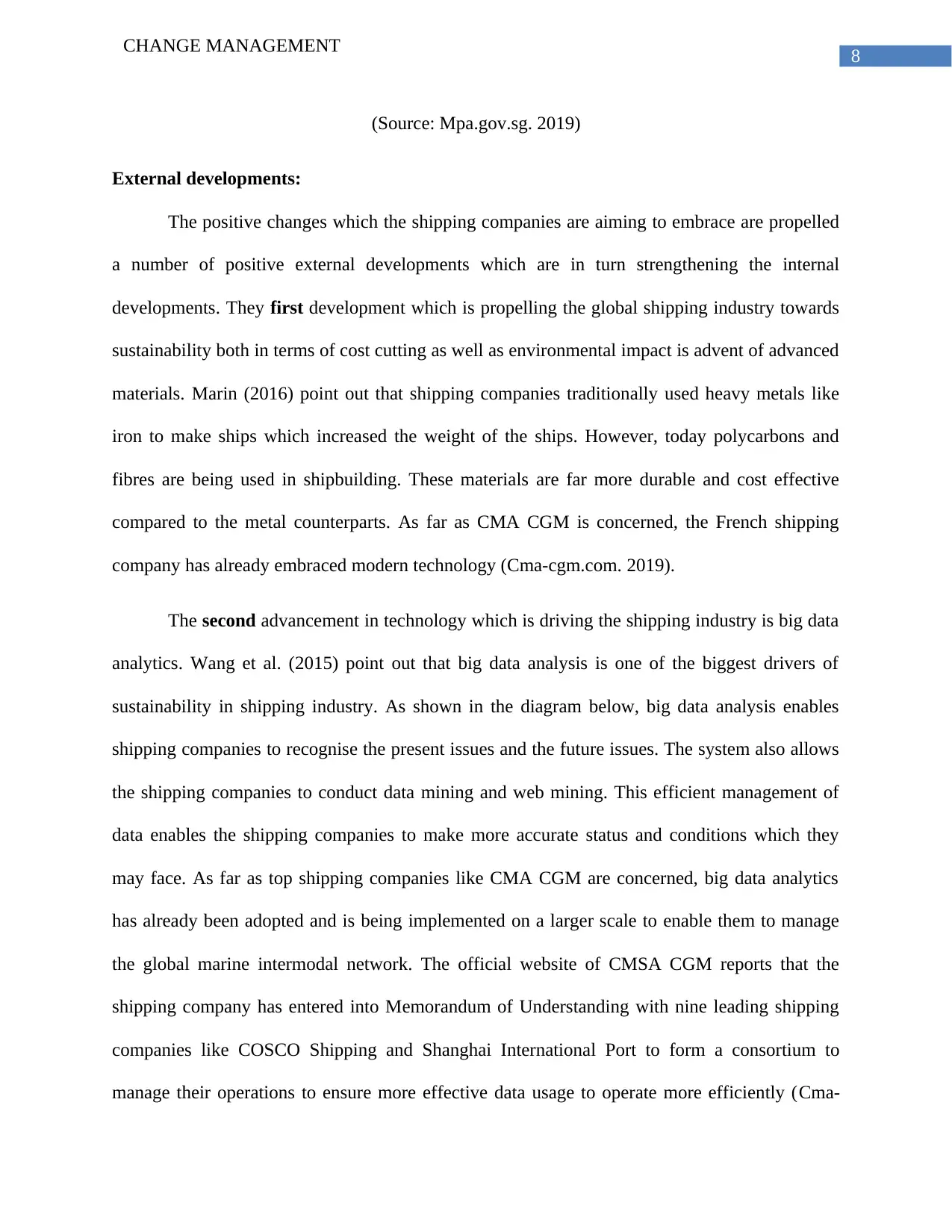
8
CHANGE MANAGEMENT
(Source: Mpa.gov.sg. 2019)
External developments:
The positive changes which the shipping companies are aiming to embrace are propelled
a number of positive external developments which are in turn strengthening the internal
developments. They first development which is propelling the global shipping industry towards
sustainability both in terms of cost cutting as well as environmental impact is advent of advanced
materials. Marin (2016) point out that shipping companies traditionally used heavy metals like
iron to make ships which increased the weight of the ships. However, today polycarbons and
fibres are being used in shipbuilding. These materials are far more durable and cost effective
compared to the metal counterparts. As far as CMA CGM is concerned, the French shipping
company has already embraced modern technology (Cma-cgm.com. 2019).
The second advancement in technology which is driving the shipping industry is big data
analytics. Wang et al. (2015) point out that big data analysis is one of the biggest drivers of
sustainability in shipping industry. As shown in the diagram below, big data analysis enables
shipping companies to recognise the present issues and the future issues. The system also allows
the shipping companies to conduct data mining and web mining. This efficient management of
data enables the shipping companies to make more accurate status and conditions which they
may face. As far as top shipping companies like CMA CGM are concerned, big data analytics
has already been adopted and is being implemented on a larger scale to enable them to manage
the global marine intermodal network. The official website of CMSA CGM reports that the
shipping company has entered into Memorandum of Understanding with nine leading shipping
companies like COSCO Shipping and Shanghai International Port to form a consortium to
manage their operations to ensure more effective data usage to operate more efficiently (Cma-
CHANGE MANAGEMENT
(Source: Mpa.gov.sg. 2019)
External developments:
The positive changes which the shipping companies are aiming to embrace are propelled
a number of positive external developments which are in turn strengthening the internal
developments. They first development which is propelling the global shipping industry towards
sustainability both in terms of cost cutting as well as environmental impact is advent of advanced
materials. Marin (2016) point out that shipping companies traditionally used heavy metals like
iron to make ships which increased the weight of the ships. However, today polycarbons and
fibres are being used in shipbuilding. These materials are far more durable and cost effective
compared to the metal counterparts. As far as CMA CGM is concerned, the French shipping
company has already embraced modern technology (Cma-cgm.com. 2019).
The second advancement in technology which is driving the shipping industry is big data
analytics. Wang et al. (2015) point out that big data analysis is one of the biggest drivers of
sustainability in shipping industry. As shown in the diagram below, big data analysis enables
shipping companies to recognise the present issues and the future issues. The system also allows
the shipping companies to conduct data mining and web mining. This efficient management of
data enables the shipping companies to make more accurate status and conditions which they
may face. As far as top shipping companies like CMA CGM are concerned, big data analytics
has already been adopted and is being implemented on a larger scale to enable them to manage
the global marine intermodal network. The official website of CMSA CGM reports that the
shipping company has entered into Memorandum of Understanding with nine leading shipping
companies like COSCO Shipping and Shanghai International Port to form a consortium to
manage their operations to ensure more effective data usage to operate more efficiently (Cma-
⊘ This is a preview!⊘
Do you want full access?
Subscribe today to unlock all pages.

Trusted by 1+ million students worldwide
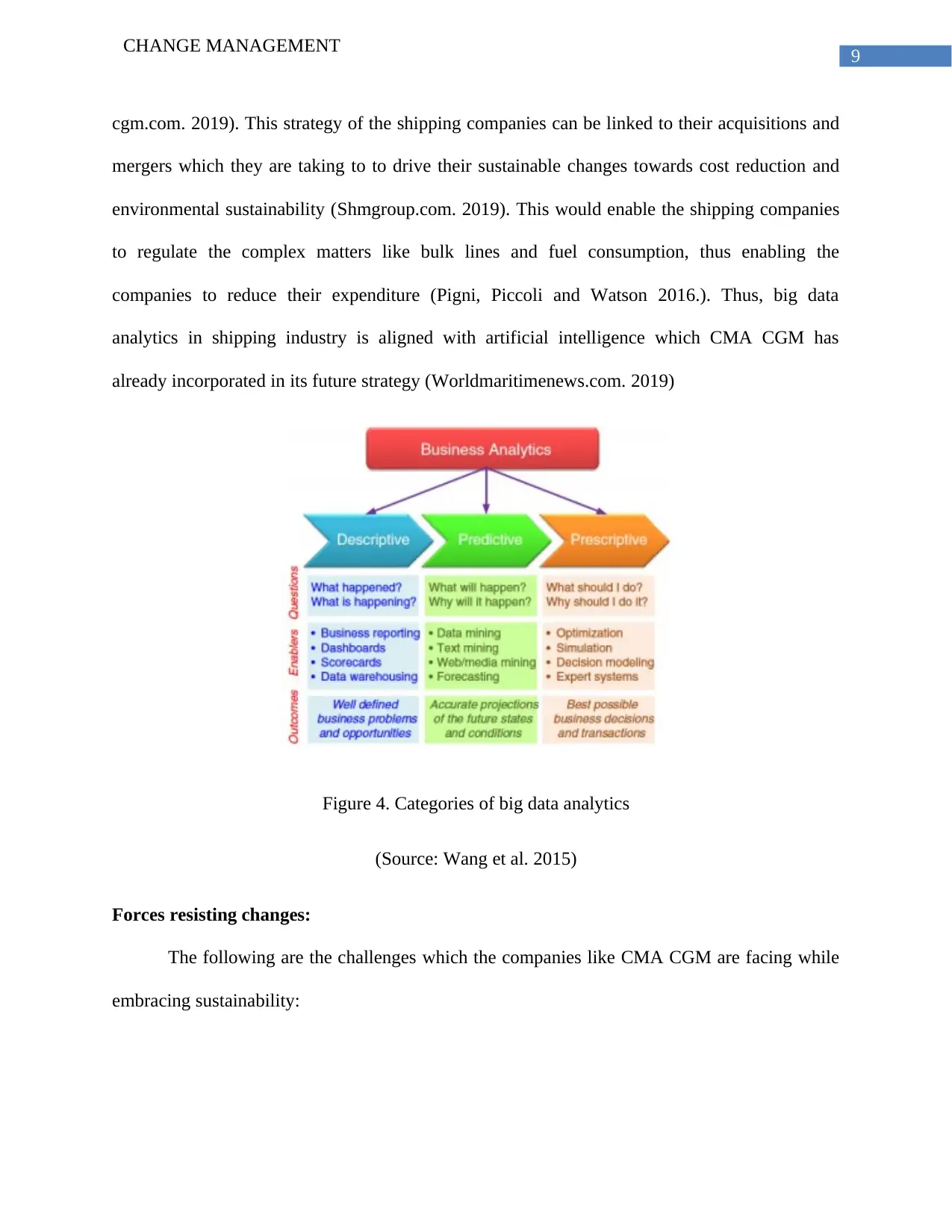
9
CHANGE MANAGEMENT
cgm.com. 2019). This strategy of the shipping companies can be linked to their acquisitions and
mergers which they are taking to to drive their sustainable changes towards cost reduction and
environmental sustainability (Shmgroup.com. 2019). This would enable the shipping companies
to regulate the complex matters like bulk lines and fuel consumption, thus enabling the
companies to reduce their expenditure (Pigni, Piccoli and Watson 2016.). Thus, big data
analytics in shipping industry is aligned with artificial intelligence which CMA CGM has
already incorporated in its future strategy (Worldmaritimenews.com. 2019)
Figure 4. Categories of big data analytics
(Source: Wang et al. 2015)
Forces resisting changes:
The following are the challenges which the companies like CMA CGM are facing while
embracing sustainability:
CHANGE MANAGEMENT
cgm.com. 2019). This strategy of the shipping companies can be linked to their acquisitions and
mergers which they are taking to to drive their sustainable changes towards cost reduction and
environmental sustainability (Shmgroup.com. 2019). This would enable the shipping companies
to regulate the complex matters like bulk lines and fuel consumption, thus enabling the
companies to reduce their expenditure (Pigni, Piccoli and Watson 2016.). Thus, big data
analytics in shipping industry is aligned with artificial intelligence which CMA CGM has
already incorporated in its future strategy (Worldmaritimenews.com. 2019)
Figure 4. Categories of big data analytics
(Source: Wang et al. 2015)
Forces resisting changes:
The following are the challenges which the companies like CMA CGM are facing while
embracing sustainability:
Paraphrase This Document
Need a fresh take? Get an instant paraphrase of this document with our AI Paraphraser
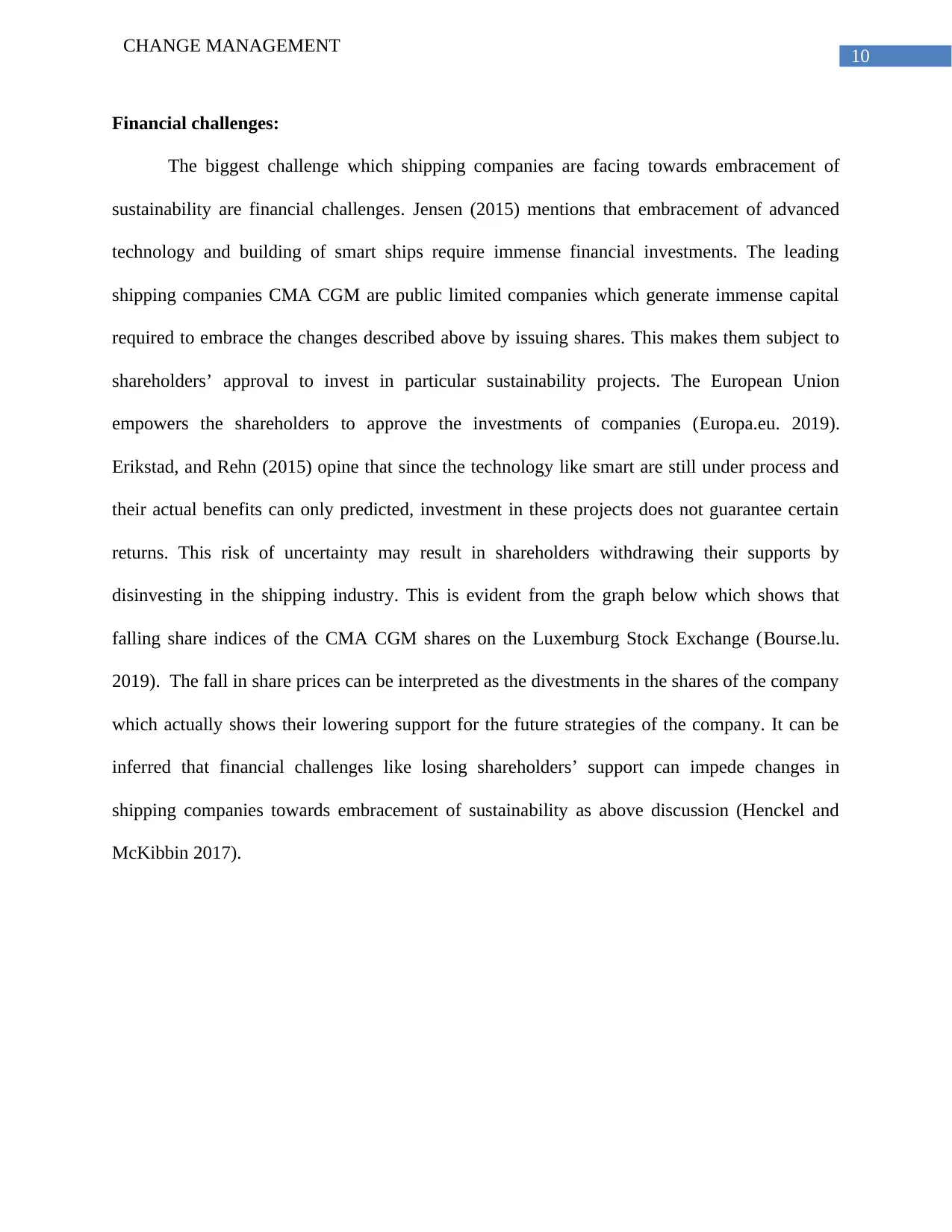
10
CHANGE MANAGEMENT
Financial challenges:
The biggest challenge which shipping companies are facing towards embracement of
sustainability are financial challenges. Jensen (2015) mentions that embracement of advanced
technology and building of smart ships require immense financial investments. The leading
shipping companies CMA CGM are public limited companies which generate immense capital
required to embrace the changes described above by issuing shares. This makes them subject to
shareholders’ approval to invest in particular sustainability projects. The European Union
empowers the shareholders to approve the investments of companies (Europa.eu. 2019).
Erikstad, and Rehn (2015) opine that since the technology like smart are still under process and
their actual benefits can only predicted, investment in these projects does not guarantee certain
returns. This risk of uncertainty may result in shareholders withdrawing their supports by
disinvesting in the shipping industry. This is evident from the graph below which shows that
falling share indices of the CMA CGM shares on the Luxemburg Stock Exchange (Bourse.lu.
2019). The fall in share prices can be interpreted as the divestments in the shares of the company
which actually shows their lowering support for the future strategies of the company. It can be
inferred that financial challenges like losing shareholders’ support can impede changes in
shipping companies towards embracement of sustainability as above discussion (Henckel and
McKibbin 2017).
CHANGE MANAGEMENT
Financial challenges:
The biggest challenge which shipping companies are facing towards embracement of
sustainability are financial challenges. Jensen (2015) mentions that embracement of advanced
technology and building of smart ships require immense financial investments. The leading
shipping companies CMA CGM are public limited companies which generate immense capital
required to embrace the changes described above by issuing shares. This makes them subject to
shareholders’ approval to invest in particular sustainability projects. The European Union
empowers the shareholders to approve the investments of companies (Europa.eu. 2019).
Erikstad, and Rehn (2015) opine that since the technology like smart are still under process and
their actual benefits can only predicted, investment in these projects does not guarantee certain
returns. This risk of uncertainty may result in shareholders withdrawing their supports by
disinvesting in the shipping industry. This is evident from the graph below which shows that
falling share indices of the CMA CGM shares on the Luxemburg Stock Exchange (Bourse.lu.
2019). The fall in share prices can be interpreted as the divestments in the shares of the company
which actually shows their lowering support for the future strategies of the company. It can be
inferred that financial challenges like losing shareholders’ support can impede changes in
shipping companies towards embracement of sustainability as above discussion (Henckel and
McKibbin 2017).
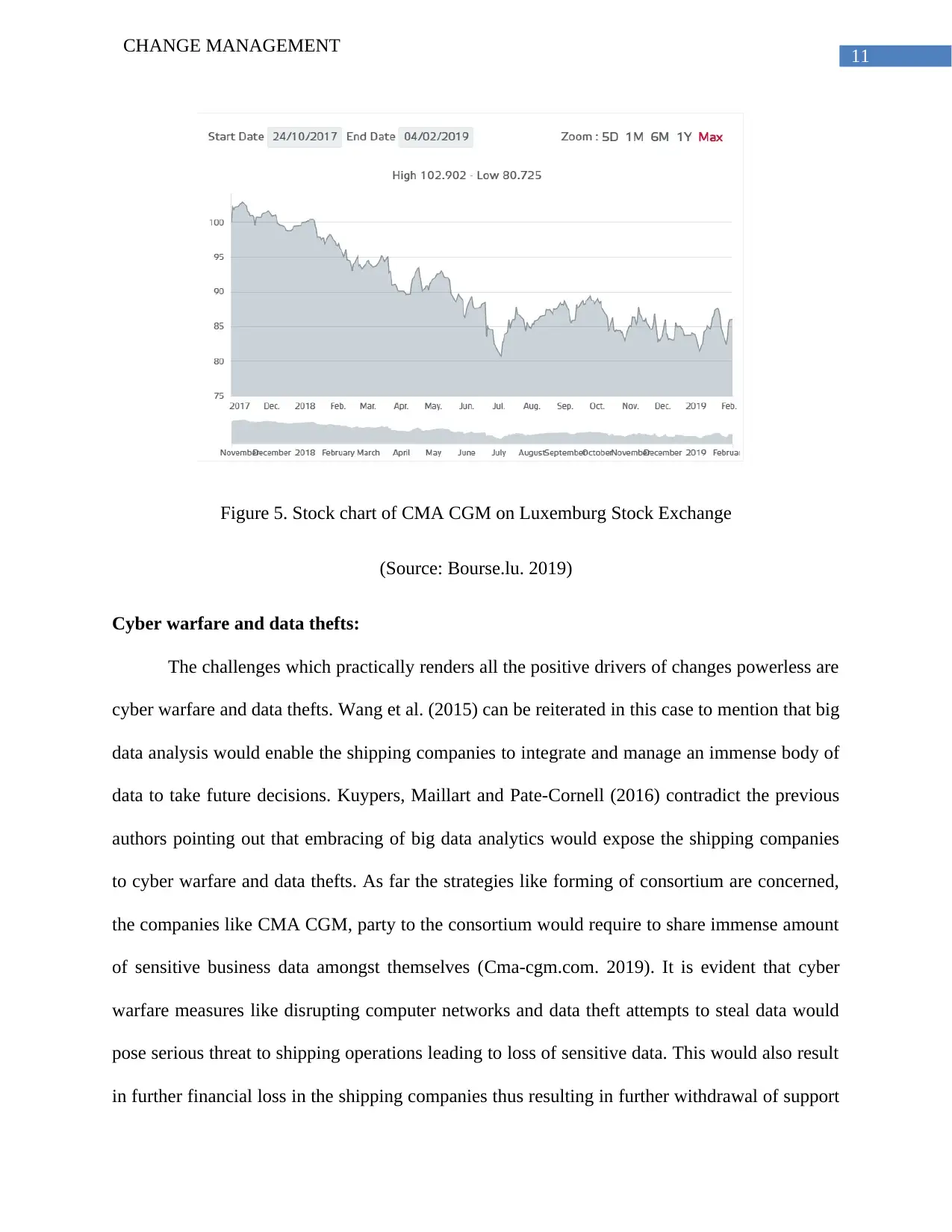
11
CHANGE MANAGEMENT
Figure 5. Stock chart of CMA CGM on Luxemburg Stock Exchange
(Source: Bourse.lu. 2019)
Cyber warfare and data thefts:
The challenges which practically renders all the positive drivers of changes powerless are
cyber warfare and data thefts. Wang et al. (2015) can be reiterated in this case to mention that big
data analysis would enable the shipping companies to integrate and manage an immense body of
data to take future decisions. Kuypers, Maillart and Pate-Cornell (2016) contradict the previous
authors pointing out that embracing of big data analytics would expose the shipping companies
to cyber warfare and data thefts. As far the strategies like forming of consortium are concerned,
the companies like CMA CGM, party to the consortium would require to share immense amount
of sensitive business data amongst themselves (Cma-cgm.com. 2019). It is evident that cyber
warfare measures like disrupting computer networks and data theft attempts to steal data would
pose serious threat to shipping operations leading to loss of sensitive data. This would also result
in further financial loss in the shipping companies thus resulting in further withdrawal of support
CHANGE MANAGEMENT
Figure 5. Stock chart of CMA CGM on Luxemburg Stock Exchange
(Source: Bourse.lu. 2019)
Cyber warfare and data thefts:
The challenges which practically renders all the positive drivers of changes powerless are
cyber warfare and data thefts. Wang et al. (2015) can be reiterated in this case to mention that big
data analysis would enable the shipping companies to integrate and manage an immense body of
data to take future decisions. Kuypers, Maillart and Pate-Cornell (2016) contradict the previous
authors pointing out that embracing of big data analytics would expose the shipping companies
to cyber warfare and data thefts. As far the strategies like forming of consortium are concerned,
the companies like CMA CGM, party to the consortium would require to share immense amount
of sensitive business data amongst themselves (Cma-cgm.com. 2019). It is evident that cyber
warfare measures like disrupting computer networks and data theft attempts to steal data would
pose serious threat to shipping operations leading to loss of sensitive data. This would also result
in further financial loss in the shipping companies thus resulting in further withdrawal of support
⊘ This is a preview!⊘
Do you want full access?
Subscribe today to unlock all pages.

Trusted by 1+ million students worldwide
1 out of 28
Related Documents
Your All-in-One AI-Powered Toolkit for Academic Success.
+13062052269
info@desklib.com
Available 24*7 on WhatsApp / Email
![[object Object]](/_next/static/media/star-bottom.7253800d.svg)
Unlock your academic potential
Copyright © 2020–2025 A2Z Services. All Rights Reserved. Developed and managed by ZUCOL.




